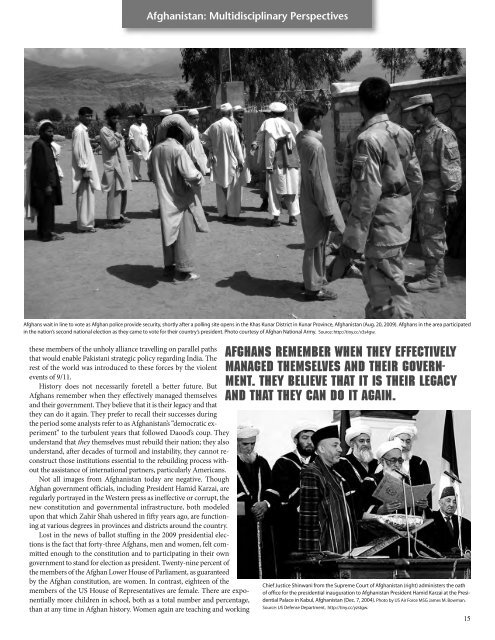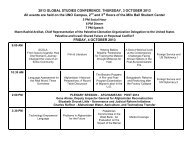What History Can Teach Us about Contemporary Afghanistan
What History Can Teach Us about Contemporary Afghanistan
What History Can Teach Us about Contemporary Afghanistan
Create successful ePaper yourself
Turn your PDF publications into a flip-book with our unique Google optimized e-Paper software.
<strong>Afghanistan</strong>: Multidisciplinary Perspectives<br />
Afghans wait in line to vote as Afghan police provide security, shortly after a polling site opens in the Khas Kunar District in Kunar Province, <strong>Afghanistan</strong> (Aug. 20, 2009). Afghans in the area participated<br />
in the nation’s second national election as they came to vote for their country’s president. Photo courtesy of Afghan National Army. Source: http://tiny.cc/v3s4gw.<br />
these members of the unholy alliance travelling on parallel paths<br />
that would enable Pakistani strategic policy regarding India. The<br />
rest of the world was introduced to these forces by the violent<br />
events of 9/11.<br />
<strong>History</strong> does not necessarily foretell a better future. But<br />
Afghans remember when they effectively managed themselves<br />
and their government. They believe that it is their legacy and that<br />
they can do it again. They prefer to recall their successes during<br />
the period some analysts refer to as <strong>Afghanistan</strong>’s “democratic experiment”<br />
to the turbulent years that followed Daood’s coup. They<br />
understand that they themselves must rebuild their nation; they also<br />
understand, after decades of turmoil and instability, they cannot reconstruct<br />
those institutions essential to the rebuilding process without<br />
the assistance of international partners, particularly Americans.<br />
Not all images from <strong>Afghanistan</strong> today are negative. Though<br />
Afghan government officials, including President Hamid Karzai, are<br />
regularly portrayed in the Western press as ineffective or corrupt, the<br />
new constitution and governmental infrastructure, both modeled<br />
upon that which Zahir Shah ushered in fifty years ago, are functioning<br />
at various degrees in provinces and districts around the country.<br />
Lost in the news of ballot stuffing in the 2009 presidential elections<br />
is the fact that forty-three Afghans, men and women, felt committed<br />
enough to the constitution and to participating in their own<br />
government to stand for election as president. Twenty-nine percent of<br />
the members of the Afghan Lower House of Parliament, as guaranteed<br />
by the Afghan constitution, are women. In contrast, eighteen of the<br />
members of the US House of Representatives are female. There are exponentially<br />
more children in school, both as a total number and percentage,<br />
than at any time in Afghan history. Women again are teaching and working<br />
Afghans remember when they effectively<br />
managed themselves and their government.<br />
They believe that it is their legacy<br />
and that they can do it again.<br />
Chief Justice Shinwani from the Supreme Court of <strong>Afghanistan</strong> (right) administers the oath<br />
of office for the presidential inauguration to <strong>Afghanistan</strong> President Hamid Karzai at the Presidential<br />
Palace in Kabul, <strong>Afghanistan</strong> (Dec. 7, 2004). Photo by US Air Force MSG James M. Bowman.<br />
Source: US Defense Department, http://tiny.cc/yzstgw.<br />
15




